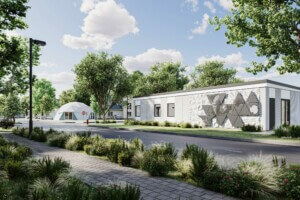Less than 10 percent of the billions of tons of plastic ever produced has been recycled, with much of it winding up in the Earth’s oceans where the plastic disrupts ecosystems and releases toxic chemicals. In response, researchers led by Neri Oxman of MIT’s Mediated Matter Group, which focuses on “nature-inspired design and design-inspired nature,” have devised a new materials that they say, in somewhat biblical terms, go “from water to water.” The substances include a structure made of biocomposite skins derived from cellulose, chitosan, and pectin, some of the most abundant biopolymers on earth, in everything from tree branches to insect exoskeletons to common fruits to human bones.
The researchers have put these new composites to the test in a 16-foot-tall pavilion named Aguahoja I (literally, water-sheet in Spanish), the culmination of six years of intense research into material science and robotic fabrication. Panels, comprising a top layer of chitosan and cellulose with a bottom layer of apple pectin and chitosan, were 3D-printed in various compositions to affect their rigidity and strength, color and color-changing abilities, transparency, and responses to heat and humidity, as well as their load-bearing abilities. This means, according to the lab, that the materials are functionally “programmable.” Because of this variability, a variety of facade or load-bearing structural components can be generated from the same process, and the size is limited only by that of the printer. This “water-based digital fabrication” is intended to create a situation in which form, function, and fabrication are more closely linked, working in a way that mimics how the natural world designs itself; the result is “a continuous construction modeled after human skin—with regions that serve as structure, window, and environmental filter,” said the lab.

In a display at the MIT Media Lab, the pavilion was shown along with a library of materials with various colors, shades, and structural properties, and an array of custom hardware, software, and wetware. The pavilion has been acquired by SFMOMA for its permanent collection, and a second version, Aguahoja II, will appear in the Cooper Hewitt’s design triennial, themed “Nature,” which opens next month.
When structures made of these materials have run their course, the materials can be dissolved in water, returning natural materials to the environment with relatively little harm or disruption, much like any organic object in a naturally occurring ecosystem that decays and returns to be reused by the life that relies on it.
For more on the latest in AEC technology and for information about the upcoming TECH+ conference, visit techplusexpo.com/nyc/.











